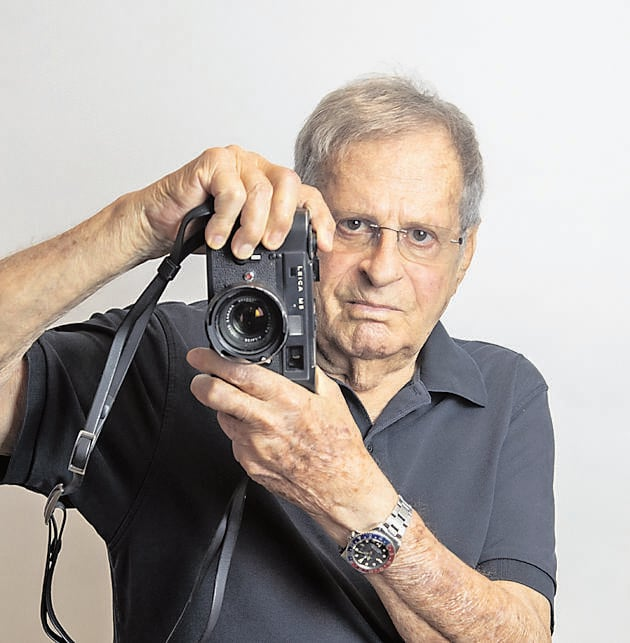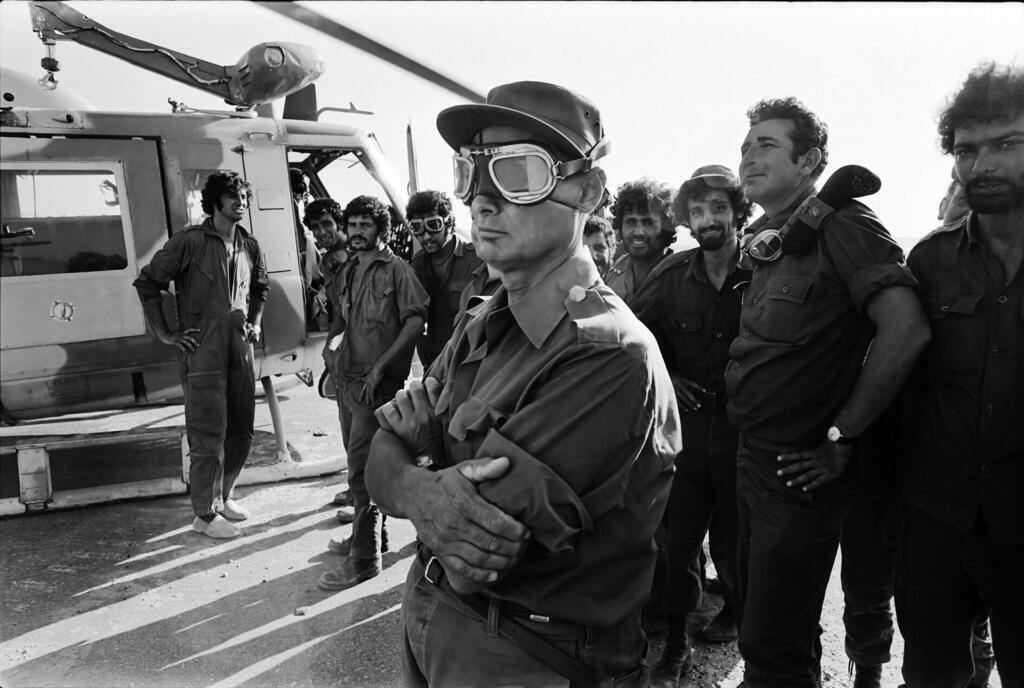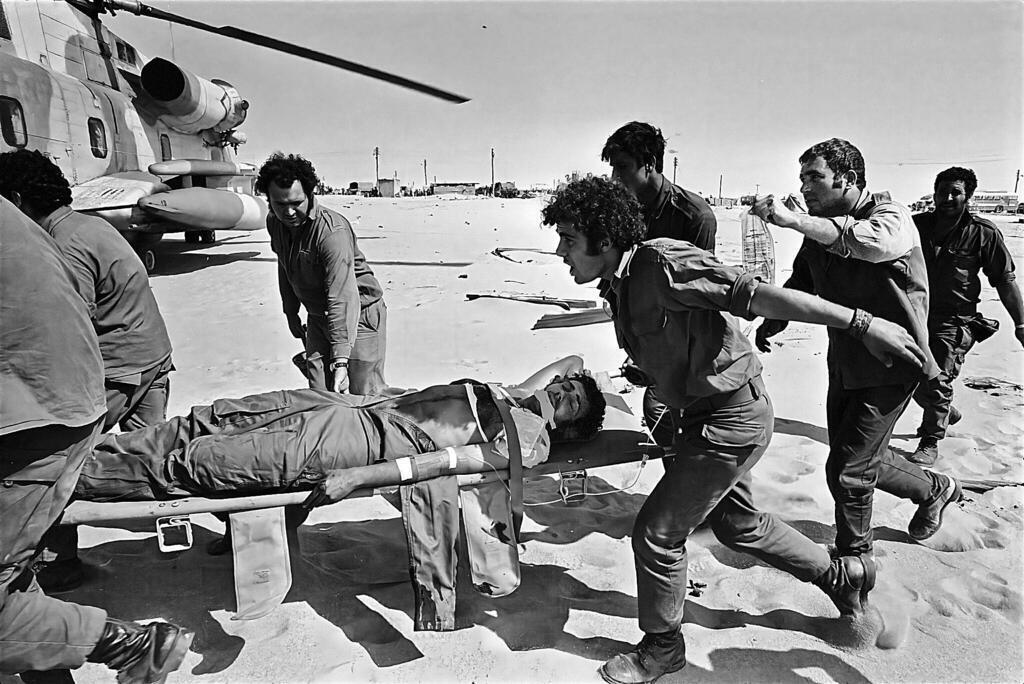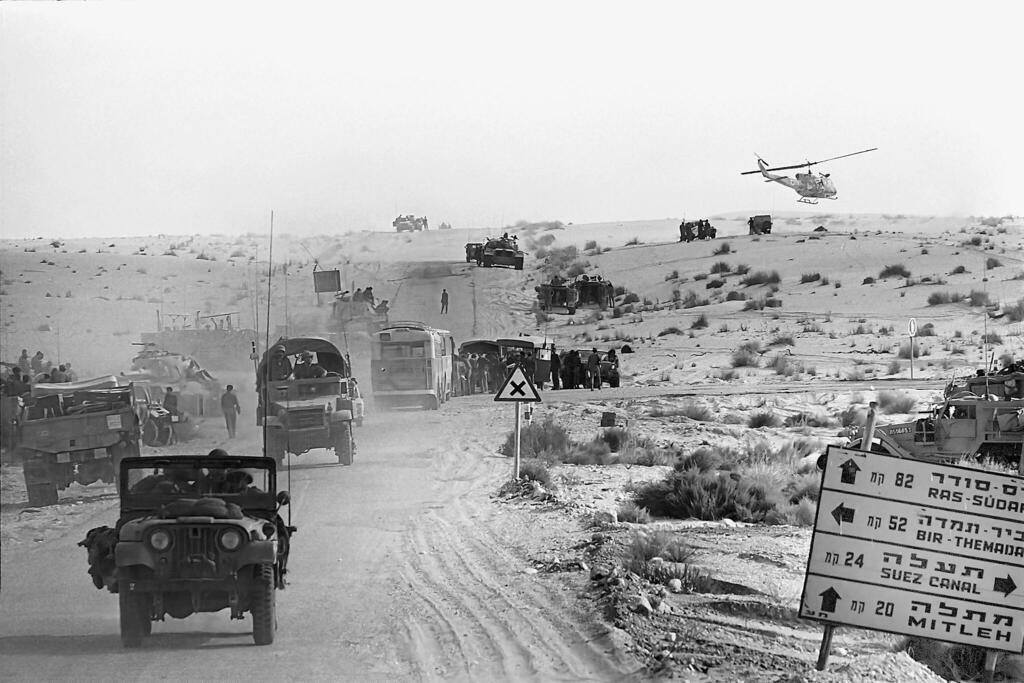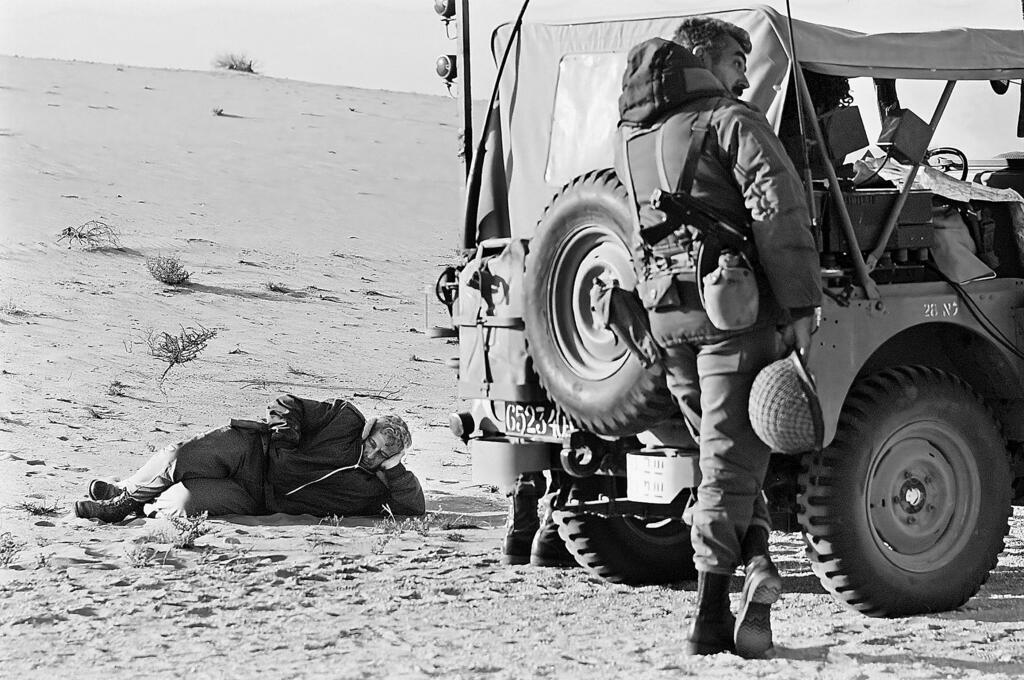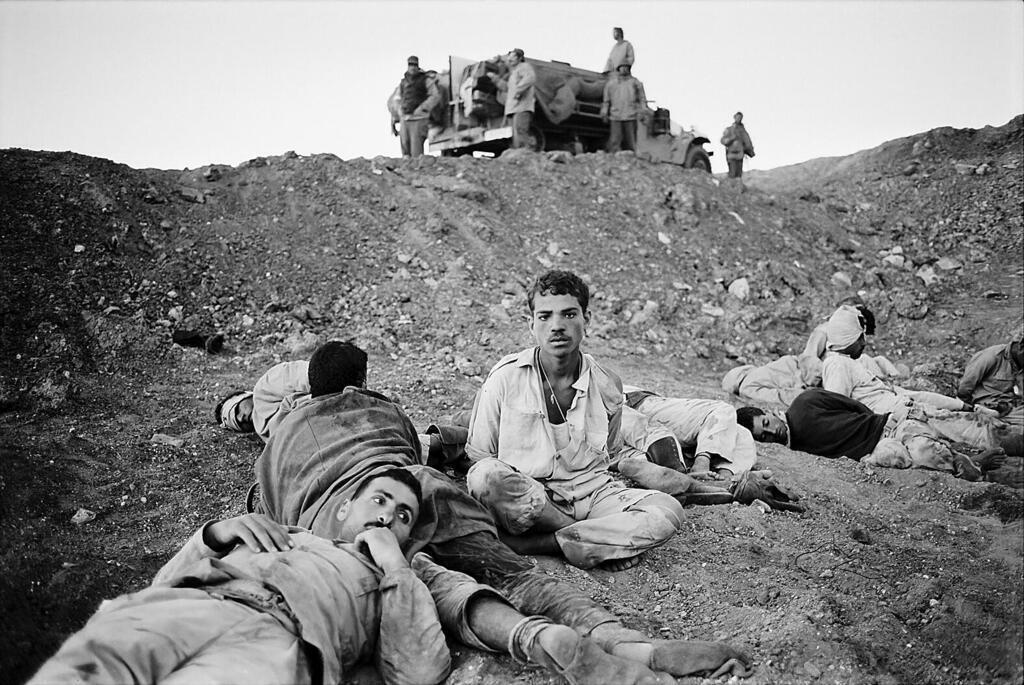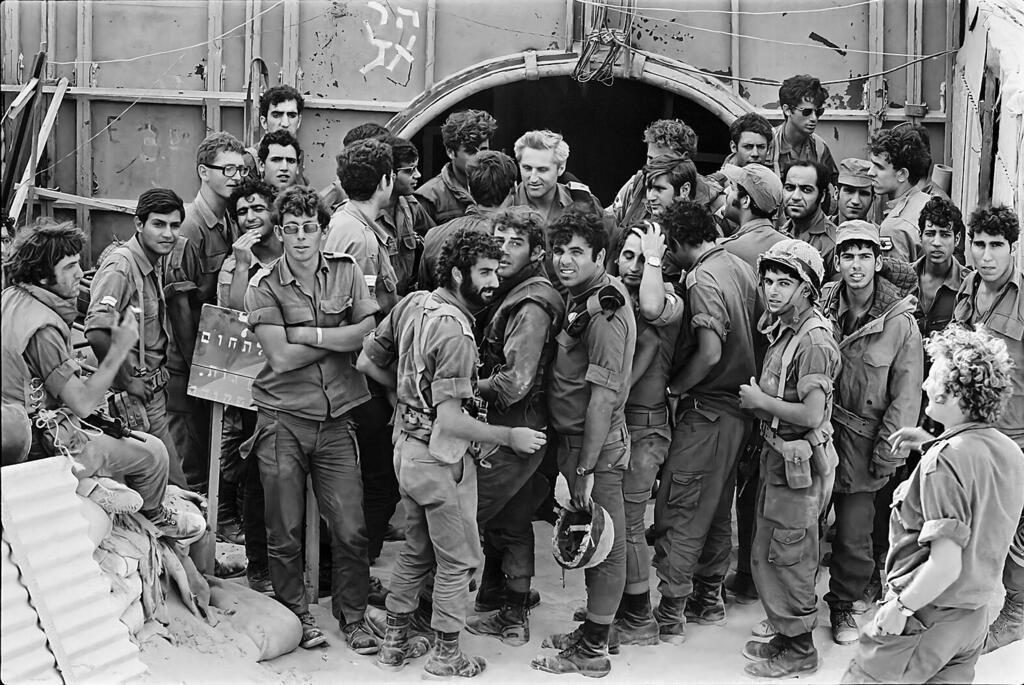The Yom Kippur War wasn't the first war covered by photojournalist Shabtai Tal, but it was certainly the most significant one for him. At the time, he was 35 years old, married to Adi, and served as the head of the Israeli desk at the esteemed German weekly Stern. When the battles commenced, Tal received instructions from Hamburg, "Head to the front line, and stay safe."
Read more:
"I traveled with Uri Dan to Arik's (referring to Ariel Sharon) house in Be'er Sheva," Tal recounts, "a small house in the D neighborhood. There wasn't a farm back then. I remember a long wooden table, with Arik sitting at the head of it, wearing IDF work clothes. On the table was a white rotary phone, and he was constantly on the phone. His children, Omri and Gilad, kept running around the table, while Lily served food. It was on October 6, around six in the evening. Then Arik said, 'The Hermon has fallen.' We left there and headed to Sde Teiman, to the brigade's headquarters."
Tal set out with a camera and a protective vest. "I didn't think about death at all," he says. "We were intoxicated with victory after the Six-Day War, and then this war came with its dreadful and terrifying outcomes.
Gradually, I absorbed the sights and the smells. I felt like I was a messenger, needing to bring these images to the rear. I still have telegrams from Stern in which the editor wrote to me that my photos took up a full eight pages, concluding with the words, 'good luck and be careful'."
Every few days, Tal would return to Tel Aviv. "I would take the accumulated films, hitchhike, and make sure the films were sent to Hamburg, to the main office. When you come to Tel Aviv, you're in shock because you've just come from hell, and yet life in Tel Aviv remains unchanged.
In the bar of Beit Sokolov, they'd drink whiskey. This transition was startling. Whenever I returned from Tel Aviv to the brigade, Lily would send me with Hungarian sausages for Arik. Arik and I didn't have much of a relationship, but he was an iconic figure. The composure with which he managed the initial days of the war was impressive."
"When they asked me why I didn't shoot in color, I replied: 'Everything was black and white, more black than white.' It was so bleak and depressing that it never occurred to me to shoot in color"
On the upcoming October 9, exactly 50 years since the outbreak of the war, Tal will come full circle. At Beit Sokolov in Tel Aviv, where whiskey was served while soldiers were being killed at the front, his photo exhibition Kan 40 Rooth Avor (translating roughly to 40 Here Over) will open for three weeks.
The name of the exhibition references the call sign on the IDF's communication network for Ariel Sharon, then the commander of the 143rd Division. Thirty-three photos were carefully handpicked by Tal and the curator Rina Castelnuovo-Hollander. Thirteen of them will be displayed as massive prints, while 20 more will be projected onto a large screen, accompanied by the original recordings from the communication networks on the Suez Canal front during the war.
"This is not a victory exhibition," emphasizes Tal. "When they asked me why I didn't shoot in color, I replied: 'Everything was black and white, more black than white.' It was so bleak and depressing that it never occurred to me to shoot in color. All this time, the films were with me at home, and I never thought to publish them. But with the war's 50th anniversary and everything happening today, I think the time has come."
Among Tal's iconic photos, who is now 84 (“and a half”) years old, are an official portrait of David Ben-Gurion and photos from the signing of the Camp David peace accords with Egypt.
"None of the wars I covered, including the Six-Day War, compared to the Yom Kippur War. The shock of what we saw plunged everyone into emotional turmoil"
In the year following the Yom Kippur War, he was sent to photograph the war in Cyprus between the Greeks and Turks. In '75, he left Saigon just a day before it fell to the North Vietnamese forces.
"But there I wasn't emotionally invested as I was in the Yom Kippur War," he says. "I was an observer from the side. Here, I felt it was in my home, in my family. None of the wars I covered, including the Six-Day War, compared to the Yom Kippur War. The shock of what we saw plunged everyone into emotional turmoil."
In '82, Tal entered Lebanon with IDF forces. "It was like a summer camp compared to the Yom Kippur War," he states. Only an injury in that war caused him to stop photographing wars.
Show and Dust
At the end of the war, on October 20, "[Moshe] Dayan, who was then the defense minister, came to visit after the canal was recaptured. He arrived in a Bell 212 helicopter. He needed the sunglasses against the dust, and also a bit for show. The picture was taken at the Fayid airfield, which is in Egyptian territory. Behind him stands his military aide, Arye Braun."
Situation Briefing
The fourth day of the war, October 9. "By this point, the generals knew that the entire line of fortifications had fallen, that some of the soldiers had been killed, others tried to escape and either succeeded or were captured. The question was, what de we do now?
"In the picture, from right to left: Dany Wolf, who was the commander of Unit 424; Yaakov Aknin, the brigade artillery officer; Moti, Arik's driver; Arik; Yehoshua Saguy, the brigade intelligence officer; Avrasha Tamir, who was the head of the Planning Directorate; and above, David Maimon, whom Arik assigned for special missions. They used to work with manual maps, but now everything is on screens.
9 View gallery
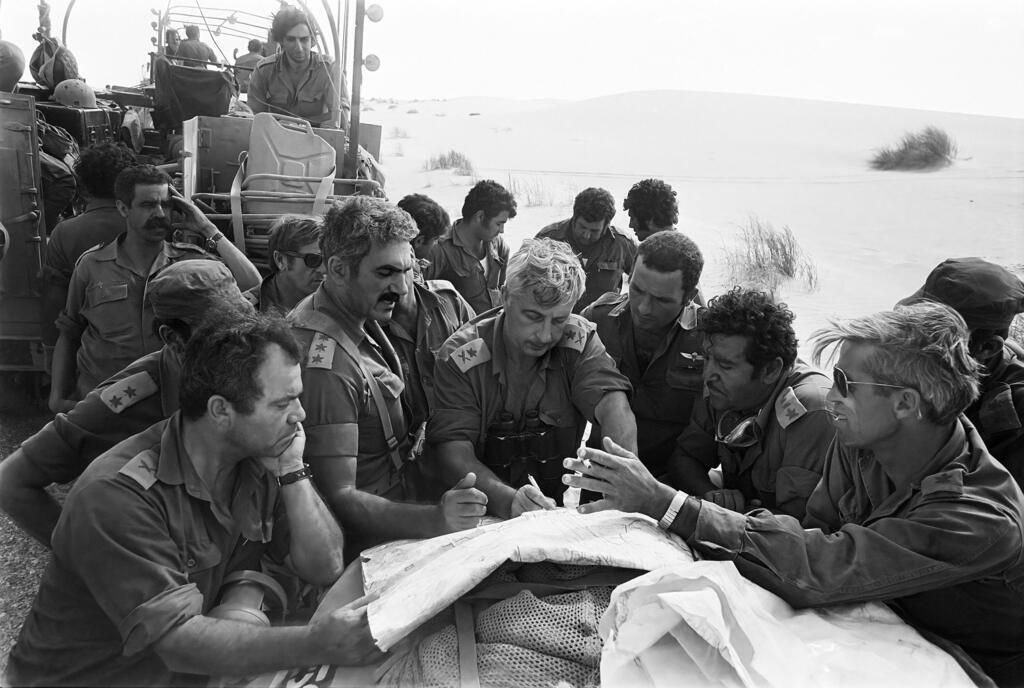

Ariel Sharon (center) and his crew during a situation assessment
(Photo: Shabtai Tal)
"In the background, you can see communication equipment, meaning that as they sit, they hear everything that's happening on the frontline. Here, Arik receives troubling updates and determines how to proceed with the war. They're looking at the map, seeing the situation, and they're in shock. I think this is where they began to snap to their senses. From here, I traveled with them to the next location. Do you think I asked anyone for permission?"
Save Us
The fourth day of the war, October 9. "Judging by the long hair of the injured, he's a reservist. Perhaps he's from the 16th Brigade that was stationed at the frontline. I don't know who the subjects in the photo are, I'd appreciate any identification.
"The photo was taken at Tasa, a military base in northwestern Sinai, 35 km (20 miles) east of Ismailia. At the beginning of the war, the headquarters of the 14th Brigade was located there, and with the arrival of the reservist forces, the camp served as a launch point for operations in the canal area. That was also the location of Arik's bunker and casualty collection point.
"When we returned to Tasa, the injured started arriving. In the medical tent, we heard with Arik the cries of the soldiers trapped in their posts, personally calling out to him, 'Come, get us out'. There's a famous recording of a guy named Maman, and Arik softly tells him, 'We'll get you out', but quietly to us, those around him, he says, 'There's no chance.' That's when I really understood the war.
"At the entrance to Arik's bunker in Tasa, there were signs of shelling, noisy like hell itself. One day, hearing the shells, I darted and lay next to one person, Sergeant [and future prime minister] Ehud Olmert from BaMahane [the IDF’s now-defunct weekly magazine], and we both buried our heads and noses in the sand, watching the bullets fly overhead."
Here Lie
October 15 or 16. "The photo was taken along the Spider Road, on the way back after successfully crossing the canal. The fact that they lie with blankets over their faces indicates they have been identified and are prepared for evacuation. One of the lessons from this war was to also place identification tags in the shoes."
9 View gallery
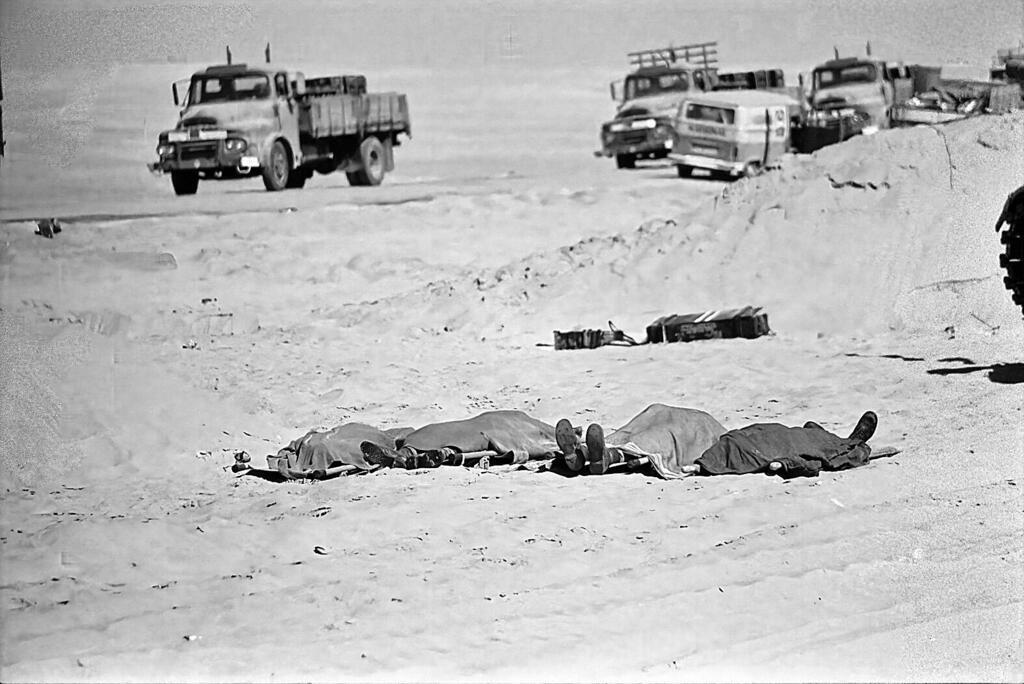

Bodies of Israeli soldiers lying on the ground covered in blankets
(Photo: Shabtai Tal)
Welcome to Chaos
The second day of the war, October 7. "This picture embodies the entire confusion and mess of this war. It was taken from Israeli territory, at a junction leading into Sinai. According to the sign, it's 24 km (15 miles) from the canal. The forces arrived and dispersed from here.
You can see a soldier walking in the middle of the road, guys getting off buses to mount the vehicles. Every vehicle here is heading in a different direction. Nowadays, you wouldn't see a picture like this. There's order in the army. Back then, the chaos was terrifying. They hadn't yet grasped what was happening."
Sleeping on the Sands
The second day of the war, October 7th, nearing noon. "We traveled with all the commanders between the hills from Camp Tasa when suddenly a barrage rained down on us, a literal shower of Katyusha rockets, turning the sky black. There was a terrible panic until two officers, Dany Wolf and Patzi (Brig. Gen. (res.) Amatzia Chen) from Unit 424, located two Egyptian forward artillery observers behind a tree who were targeting us. They neutralized them and the fire ceased.
“Then Arik took a moment and caught a few minutes of sleep. I presume a huge weight was lifted from him because in the span of those two barrages, the entire command could have been wiped out.
“The man standing to the right of the jeep is Yehoshua Saguy, the brigade's intelligence officer, who later became the head of the Military Intelligence Directorate and subsequently the mayor of Bat Yam.
“In such situations, you don't order people around. You don't tell someone standing next to a senior officer to 'move'. When I took this photo, I was still shaking. For me, it was traumatic. I remember telling myself, 'This is no longer the Six-Day War, this is a whole different story’."
Facing the Enemy
"Taken in the 'Courtyard of Death', where the Egyptian prisoners were gathered. I looked at them and thought, 'Oh my, they are just kids, so young.' I observed their humiliation and thought of our prisoners in their custody. I am certain that ours did not appear as downtrodden as they did. My heart ached for them."
Heat of Battle
The second day of the war, October 7th, near Sharon's bunker. "Ironically, senior reserve officers don't have much to do during wartime, but around Arik, high-ranking officers always liked to gather. Chich (Shlomo Lahat, who later served as mayor of Tel Aviv), who was a senior officer in the reserves, had come from home. You can see how everyone looks disheveled, but he stands out, on point like a Prussian officer.
The men around him are fighters, and there are many drivers and radio operators who came to take a photo with the famous figure. There was another reason: in those days, it was impossible to call families or send messages, so when people saw a photographer, they flocked to be photographed, hoping it would be published in one of the newspapers and their families would know they were alive."


